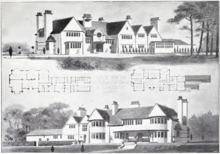Shackleford
[4] It has also been suggested that the element might derive from an unattested Old English noun akin to Old High German scahho 'strip or tongue of land' or to Old Norse skekill as in útskekill 'the outskirts of a field', but there is nothing in the local topography pointing to such meanings.[5] Whatever the etymology, in 1349 a John de Shackleford was one of three persons enfeoffed of a nearby manor;[6] his surname, which at that relatively late date was most likely hereditary, doubtless referred to the Surrey village.[7][8] Meanwhile, Hurtmore Manor was held by Sir Edward More of Odiham who before his death in 1623 left this to his daughter and her husband Sir William Staunton, recusant convict, and stating he should have the house free of rent for life – the manor was sold by later relatives to executors of Simon Bennett of Calverton, one of the daughters of whom married James Cecil, 4th Earl of Salisbury (when still styled by the courtesy title Viscount Cranborne) and his son James Cecil, 5th Earl of Salisbury inherited the share of the two Bennett daughters; his grandson James Cecil, 1st Marquess of Salisbury sold the estate with much later belonging to the Richardson, Keen and Frankland families.An arc of wet heath soil is to the south-east, south, south-west, west and north-west of the village centre, covering all of Norney and Gatwick.The remainder of the soil is in common with Godalming, "free draining slightly acid loamy" and is the dominant type in the centre of Shackleford, as well as throughout Eashing and Hurtmore.A hot air balloon provider, Reach 4 The Sky, operates flights from the land behind the pub cottages, historically used as a chalk quarry.Its interior is just as remarkable as its exterior, with among many carved features, a green marble chimney breast in end room to left and a half-dome ceiling with gallery landing to the rear.[23] To the south-west is a late 17th-century two-storey galleted coursed sandstone home with red brick dressings facing its round front drive, which is listed.[24] During the reign of King Alfred the Great an Anglo-Saxon burh was constructed at Upper Eashing as a defensive point to resist Viking attacks.The proportion of households (a sizeable minority of which share buildings) in the civil parish who owned their home outright compares to the regional average of 35.1%.
Shackleford (disambiguation)Villagecivil parishSurreyDensityOS grid referenceDistrictGuildford (borough)Shire countyRegionSouth EastCountryEnglandSovereign statePost townGodalmingPostcode districtDialling codePoliceAmbulanceSouth East CoastUK ParliamentGodalming and AshBorough of GuildfordGuildfordPetersfieldLondonDomesday BookGertrude JekyllCock TavernWhitehall Palacerecusant convictCalvertonJames Cecil, 4th Earl of Salisburycourtesy titleJames Cecil, 5th Earl of SalisburyJames Cecil, 1st Marquess of SalisburyPortsmouthFarncombelisted buildingsGeorge Gilbert ScottNorneyOxshottWeybridgeWisleyWokingBrookwoodDeepcutPirbrightFrimleyLightwaterCamberleyChobham CommonVirginia WaterOttershawWentworthCharles James FoxSamuel LewisWaverley AbbeyRiver WeyHundred of GodalmingBurghal HidageAlfred the GreatGuildford Borough CouncilA3 roadpublic houseNoel FitzpatrickComptonCharterhouse SchoolTudor periodReigate and Bansteadof the same nameSurrey Wildlife TrustPuttenham & Crooksbury CommonsCharles Voyseylisted buildinglimestoneThe DigEdith PrettySutton HooSecond World WarEastbournegalletedsandstoneAnglo-SaxonVikingBargate stonevoussoirsparapetcutwatersacross and in Puttenham & Crooksbury CommonsPuttenhamSeale and SandsTilfordElsteadPeper HarrowOckford Ridge, GodalmingMilfordLondon WaterlooFarncombe, Godalming railway stationGodalming railway stationAshley ColeCheryl ColeSir Edgar HorneSir David OrrUnileverSir David Randall PyeUniversity College LondonList of places of worship in Guildford (borough)Congregationalist ChurchCarpenters' CompanyLivery Companies2011 United Kingdom censusOffice for National StatisticsHistoric EnglandNational Heritage List for EnglandOrdnance SurveyEnglish HeritagelistingAlburyArtingtonAsh ValeBurntcommonBurphamChilworthEast Clandon